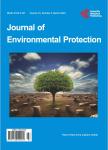Seasonal and Spatial Variation of BTEX in Ambient Air of Delhi
Seasonal and Spatial Variation of BTEX in Ambient Air of Delhi作者机构:Environmental Science Division CSIR-CRRI New Delhi India Environmental Science Division AcSIR-CRRI New Delhi India
出 版 物:《Journal of Environmental Protection》 (环境保护(英文))
年 卷 期:2016年第7卷第5期
页 面:670-688页
学科分类:07[理学] 070602[理学-大气物理学与大气环境] 0706[理学-大气科学]
主 题:VOCs Benzene Toluene Xylene Ethylbenzene
摘 要:The present study aims to provide an indication of ambient levels of BTEX in the immediate vicinity of petrol filling stations in Delhi & other road side corridors of Delhi. In this study spatial and seasonal variation of BTEX has been measured at different locations in Delhi. For the measurement of VOCs, passive based diffusion methodology was adopted for the adsorption of BTEX over the activated charcoal. Four categories of sampling sites were chosen (residential, traffic junctions, road side corridors and petrol pumps). The result confirms that the aromatic concentrations in the ambient air of gas stations are appreciably higher than the average values in locations with high vehicular flux. The mean concentration of BTEX at all the locations was 0.622μg/m3, 0.361 μg/m3, 1.037 μg/m3 and 0.122 μg/m3. The average concentration of benzene was highest at petrol pump 3.5 μg/m3 however at all other sampling sites it was in the range of 0.294 to 0.712 μg/m3. The mean concentration value shows that the xylene concentration dominates more in Delhi as compared to benzene. The total average BTEX concentration at road side corridors was 0.594 μg.m-3, at residential corridors was 0.262 μg.m-3, at intersections it was 0.649 μg.m-3 and at petrol filling stations it was 1.457 μg.m-3. The concentration was in the order of petrol filling stations intersections road side corridors residence. These data show the predominance of diesel driven vehicles in Delhi since xylene mainly comes from diesel exhausts. The influential VOC species in case of diesel engine exhaust are benzene, ethylbenzene, xylenes, propane, n-decane and undecane and in case of gasoline vehicle exhaust influential species are benzene, ethylbenzene, 1,2,4-methylbenzene, 1,3,5-methylbenzene, n-hexane and 2-methylhexane. So xylene is mainly coming from diesel exhaust since gasoline vehicle exhaust doesn’t show this



